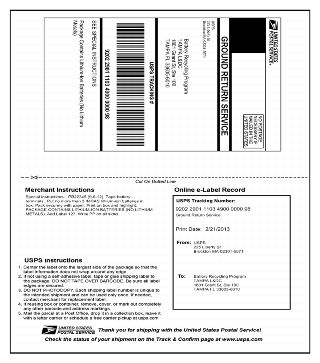Effective March 4, 2013, this standard operating procedure (SOP) establishes revised processes for handling and recycling lithium-ion batteries used in the Intelligent Mail Data Acquisition System (IMDAS) through the Battery Recycling Program in Tampa, Florida, in accordance with Postal Service™ policies and universal waste-management regulations. This SOP establishes methods for recycling IMDAS lithium-ion batteries throughout the Postal Service. All employees are required to follow approved disposal and recycling procedures for used batteries. This update also includes new procedures for mailing the batteries using an Intelligent Mail barcode that can be printed at an online website.
Universal waste is a subcategory of hazardous waste that is subject to less restrictive environmental regulations, as long as it is recycled. Federal environmental regulations require that all universal waste be recycled. Certain types of batteries are considered hazardous because they contain heavy metals or corrosive electrolyte solutions. These include, but are not limited to, lithium (LI), lithium-ion (Li-ion), and lithium polymer (Li-poly). When these batteries die, they must be handled as universal waste.
Lead-acid automotive batteries, industrial vehicle batteries, sealed lead-acid emergency batteries are designated as universal waste, but are not covered by this SOP. Dry cell batteries are not considered universal waste, but are also not covered by this SOP. For guidance on recycling dry-cell batteries, see SOP: Recycling Small Dry Cell Batteries.
When an inoperable IMDAS battery is removed from a piece of equipment, make sure that the battery is Out of Warranty, which is 17 months past the printed date or expiration date. Put a slash across the battery to identify it as “Inoperable,” and place tape over the terminals.
IMDAS lithium-ion batteries have specific mailing requirements — no more than three lithium-ion rechargeable batteries can be mailed together.
Mailing requirements for IMDAS lithium-ion batteries are described in Mailing Standards of the United States Postal Service, Domestic Mail Manual (DMM®), Section 601, Mailability Standards, 10.27.1, Lithium Battery Mailability.
Note: The DMM also calls them “Primary Lithium Batteries.” The DMM shipping standards are online at: http://pe.usps.com/text/dmm300/601.htm#xd_601_10_20_7 .
1. Select a small, sturdy cardboard box. If opting for a used box, remove or cover all barcodes.
2. Place no more than three IMDAS lithium-ion batteries into the box and pack them securely with paper. To prevent short circuits, tape all battery terminals so they don’t have contact with one another.
3. Tape the box shut. Do not use Priority Tape or Priority Boxes.
4. Print the following address label from the following link: https://www.uspsreturns.com/CreateLabel.aspx?ID=102&DisplayType=Customer&ShippingInfoIncluded=No
a. You will be instructed to enter your facility address.
b. For Package & Shipping Information, enter Lithium Batteries.
c. Click next and follow printing instructions.

5. On the printed label, highlight the rectangle “See Special Instructions. Package contains Lithium-Ion batteries”
6. Cut out the label and tape/glue the label on the box.
7. Do not use Priority Tape or Priority Boxes.

Never Ship Damaged Batteries. Batteries that are leaking, burned, cracked, melted, or otherwise damaged must be recycled locally using a hazardous waste company under contract with the USPS.
Keep records of the batteries you send. A sample record-keeping table is shown below:
Contact the Office of Sustainability with any questions about onsite, universal waste-management procedures. Guidance on proper battery storage and labeling can be found on the Office of Sustainability website at http://blue.usps.gov/sustainability/.
— Corporate Sustainability Initiatives,
Office of Sustainability, 3-21-13
